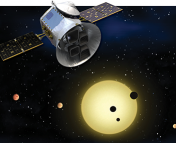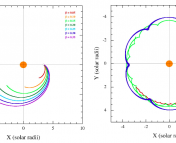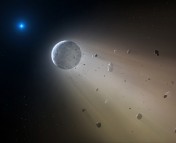Title: TOI-1075 b: A Dense, Massive, Ultra-Short Period Hot Super-Earth Straddling the Radius Gap
Authors: Zahra Essack, Avi Shporer, Jennifer A. Burt, et al..
First Author’s Institution: Department of Earth, Atmospheric and Planetary Sciences, Massachusetts Institute of Technology, Cambridge, MA 02139, USA & Kavli Institute for Astrophysics and Space Research, Massachusetts Institute of Technology, Cambridge, MA 02139, USA
Status: Submitted to AJ [open access]
Since the Kepler telescope first turned its eye to the cosmos, we have found a zoo of exoplanets – planets orbiting stars other than our Sun – with wildly different characteristics. Some are molten lava worlds that rain rocks, others are behemoths multiple times the size of Jupiter or tiny worlds a third the radius of Earth. In 2018, TESS succeeded Kepler as our foremost planet hunting telescope, constantly surveying the sky for targets to add to our ever-growing planetary menagerie. The authors of today’s paper investigate one of the thousands of stars selected for observations with TESS and find that it hosts one of the hottest and fastest super-Earths we’ve found, potentially with a sibling!
Starry Speckles Sus Out Siblings
First, the authors turn their attention to the host star, TOI-1075. Using data from Gaia of the star’s position, brightness, and motion, they find that this star lives at the cooler and dimmer end of the Main Sequence. In order to characterize the star, they fit its spectral energy distribution, which shows how much energy it emits over a range of wavelengths. Fitting a stellar atmosphere model to this, they estimated this star to be an “M-dwarf” – smaller and less massive than our Sun.
In order to attest that any signals from their exoplanet search was due to a planet and not any binary star companions that might be lurking very close to TOI-1075, the authors performed speckle imaging of this target. This technique relies on taking many very short exposure images of the star to reveal grainy bright blobs – speckles – spread over the image due to atmospheric turbulence. If the images were longer exposure, the speckles of the two stars would blend together and masquerade as a single star. With very short exposures, you would see two distinct speckle patterns alerting you to the presence of a sneaky stellar companion. Based on this imaging and through a search for nearby stars in the Gaia catalog, the authors make the well-justified assumption that TOI-1075 leads a solitary life.
What’s Cookin’?
TESS is specifically designed to observe exoplanet transits: if a planet’s orbit causes it to pass in front of its host star’s disk, it will cause the star to dim while the planet is transiting across the star’s surface. Astronomers can measure this dimming by looking at the star’s lightcurve, displaying its brightness over a period of time. The brightness will decrease and appear as a dip in the curve as a planet passes in front of its host. TOI-1075’s lightcurve and best fit to the data is shown below in Figure 1. From this, we see that the planet orbits its star in just 0.605 days (14.5 hours), making it an ultra-short period planet! After vetting that this dip isn’t a false positive from an eclipsing binary, the star and planet duo was named a TESS Object of Interest (hence the name TOI).
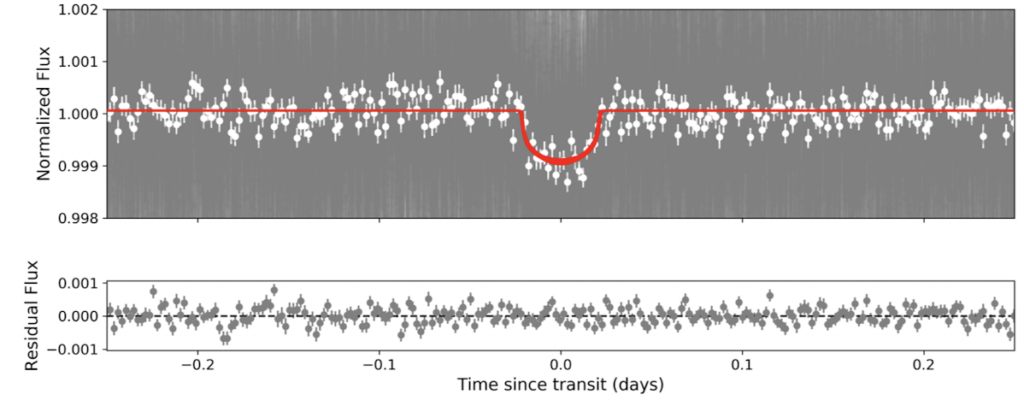
Once the team knew they were dealing with an actual new exoplanet (and an incredibly speedy one at that!), they quickly used a specialized software to predict when this planet would transit again and scheduled lots of follow-up observations with various ground-based telescopes to characterize it. Besides getting additional transit photometry, they also used the Planet Finder Spectrograph on one of the Magellan telescopes to get radial velocity (RV) measurements of the star. Measuring a star’s RV is another very common indirect exoplanet detection method. Instead of looking at a star’s brightness, this method records how fast it wobbles from side to side due to the small – but measurable – gravitational tug any exoplanet exerts on it. After modeling and finding best fits to their transit and RV data, the authors find that TOI-1075 b is an exoplanet ~10x the mass, ~1.8x the radius, ~5x the temperature, and ~1.7x as dense as Earth’s.
A Rare Ingredient
While finding just another planet might seem like a drop of water in the planetary ocean, the characteristics of this hot behemoth have some really interesting implications for our understanding of exoplanet formation, atmospheres, and compositions.
Its radius–being between 1-2 REarth–sets TOI-1075 b as a “super-Earth”. Surprisingly, if you look at the distribution of radii in small exoplanets orbiting close around Sun-like stars, we see a dearth of planets right around the radius of TOI-1075 b. Dubbed the “radius gap” or “radius valley”, astronomers still aren’t quite sure why this bimodality exists, but there are a few theories that rest on the idea of atmospheric loss: either you get larger planets with thick hydrogen/helium atmospheric envelopes further out from their host star, or close-in, small, rocky planets whose atmosphere has been lost due to 1) photoevaporation: planets lose their atmospheres due to being bombarded by intense radiation by their host star and leave behind smaller rocky cores, 2) core-powered mass loss: after forming, the cores of planets cool down and their luminosity erodes its atmosphere away, or 3) gas-poor formation: planets that are formed are either rocky or non-rocky, and non-rocky planets form in environments without much gas to begin with.
If you plot a distribution of exoplanets in orbital period-radius space, you can measure the slope of the radius valley (see Fig 2). This measurement can distinguish between the three previously-listed theoretical models for why the radius gap occurs, and differs depending on the type of host star a set of exoplanets is orbiting. For TOI-1075, an “M-dwarf” star smaller than our Sun, it’s exoplanet lives in a sweet spot – right in the middle of the radius valley, in between slopes predicted from photoevaporation and gas-poor formation. So while the authors can’t tell which of these models is the winner, TOI-1075 b adds a crucial data point for testing these radius valley models further and telling apart different mass-loss mechanisms.
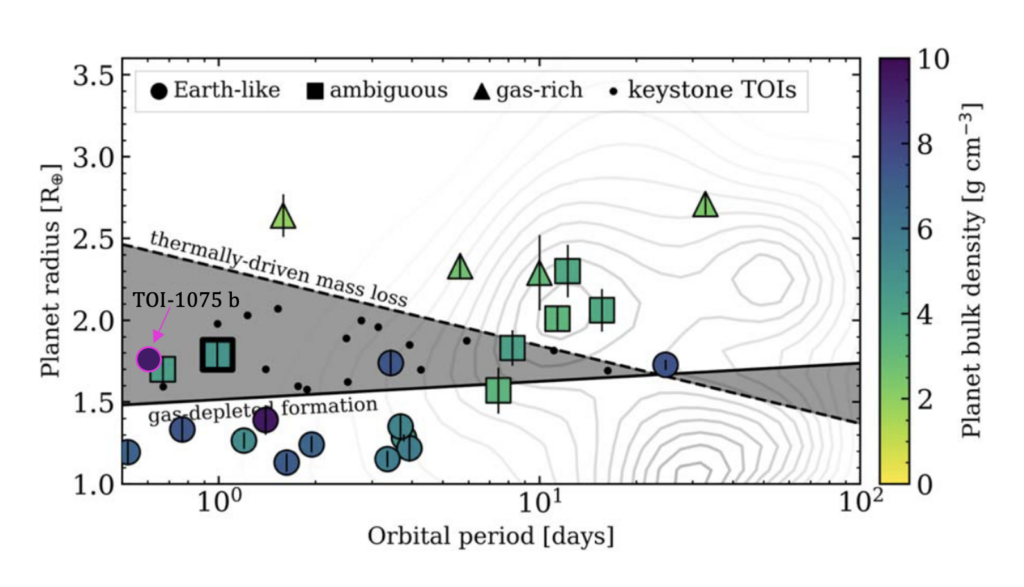
We don’t yet know what kind of atmosphere TOI-1075 b hosts (if any!), but the authors believe it’s a great candidate to follow-up with JWST’s emission spectroscopy capabilities to see if it might have vaporized metals or silicates in its atmosphere from being so hot or a thin atmosphere of H/He or CO2. Digging deeper down, by numerically simulating the exoplanet’s interior, they predict that it has an Earth-like, rocky composition. Not only is this planet one of the densest and most massive super-Earths ever found, but by looking at trends in its RV data, the authors see evidence for another possible planet in this system! Though the period of this planet is longer than their current observations and therefore wasn’t measured exactly, the observations point to it being similar to Earth, making its way around in at least 353 days. Using this estimate and assuming it’s on a circular orbit, the authors calculate that it should be 87 times the mass of Earth, a veritable giant compared to its already massive sibling. Hopefully with more TESS observations (already scheduled for July 2023!) and with JWST spectroscopy, we can get an even better grasp of TOI-1075 b’s atmosphere and composition and start characterizing its potential companion to understand more of the wild worlds hiding in the cosmos.
Astrobite edited by: Liza Sazonova
Featured Image Credit: ESO/spaceengine.org

